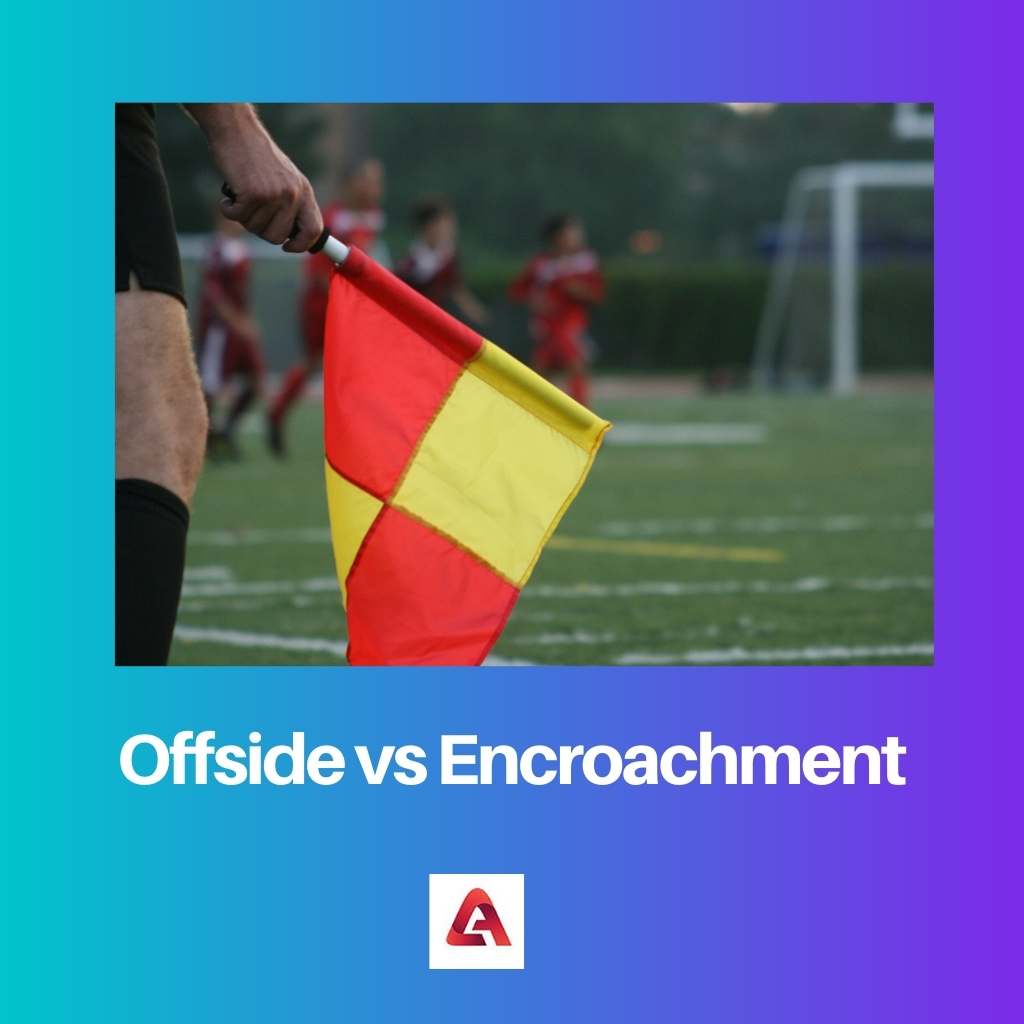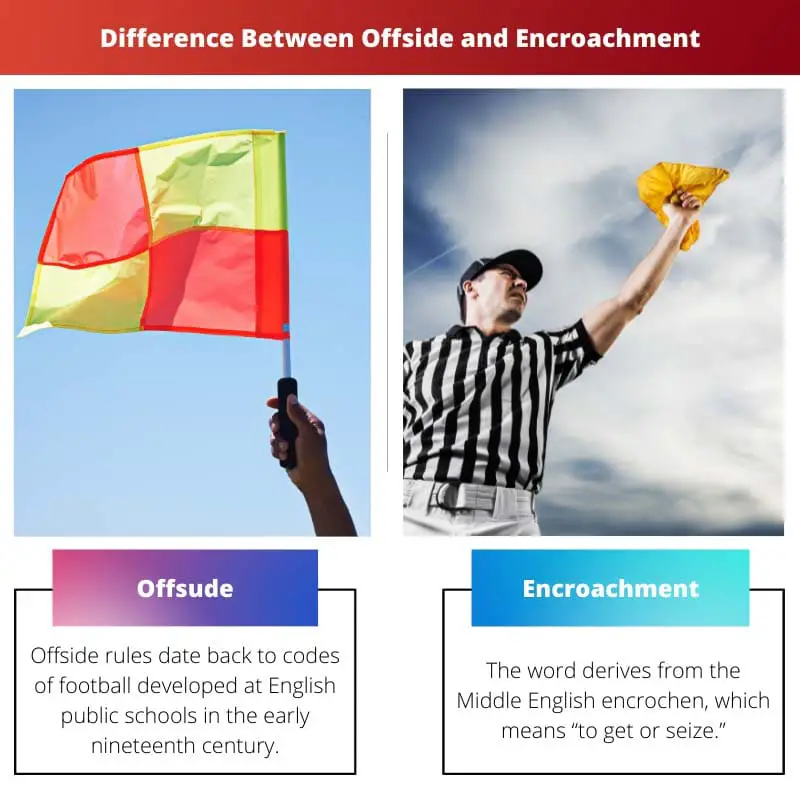Football is among the most famous games which are spread throughout stretches of continents, and it follows a system of regulations similar to every other activity. These regulations must be followed, or else fines or exclusions may be imposed.
With so many diehard fans, all affected parties must adhere to the game regulations, including fans, athletes, and club managers.
Offside, encroachments, and neutral zone violations are among them. And this article specifically talks about the differences between offsides and encroachments.
Key Takeaways
- Offside is a violation in football when a player is closer to the opponent’s goal line than the ball and the second-to-last defender.
- Encroachment occurs when a defensive player crosses the line of scrimmage before the ball is snapped.
- Offside relates to player positioning, while encroachment involves premature movement.
Offside vs Encroachment
Offside is the zone violation in soccer that happens when any parts of a player’s body are closer to the opponent’s goal than their keeper. Encroachment is an offense in American football that happens when a defender crosses the line of scrimmage illegally, and there’s impact with another player.

Offside can also be penalized against the offense, however, this is uncommon because the offensive has no motivation to line up offside, while maneuvers that send a defender offside first before snap instead are punished as false dawns.
The linesman can also assist receivers who are positioned up wide well before the snap by signaling that they are away from the line of scrimmage – receivers will check to the boundary to ensure they aren’t lined up offside.
Encroachment is defined as being offside after impact OR having a clean route to the quarterbacks. This only occurs whenever a quarterback can convince a defender to jump near the line of scrimmage with just a strong count.
These can occur whenever players make a mistake when attempting to synchronize the snap count.
When an encroachment violation occurs, the play is instantly called dead. They won’t let the play continue since it puts the attacking players in danger of getting hurt.
Comparison Table
| Parameters of Comparison | Offside | Encroachment |
|---|---|---|
| Meaning | A player is in an offside position if any of their parts, except their hands and arms, are nearer to the opponent’s goal than the goalkeeper. | When a defender toes the border of scrimmage well before the snap as well as connects directly with an attacking player, or if they have a clearer path to the passer. |
| Etymology | Offside rules date back to codes of football developed at English public schools in the early nineteenth century. | The word derives from the Middle English encroached, which means “to get or seize.” |
| Games | Soccer, American Football, futsal, rugby, and Canadian soccer. | Soccer and American Football. |
| Consequences | Free kick or penalty kick. | Play is dead instantly, and a penalty kick is offered to the non-guilty team. |
| Preventions and Cautions | The attackers must observe the line of scrimmage and take care of the lineman’s instructions. | Until the ball is played, the defensive goalie must stand on the goal line, opposite the kicker, between the goal line. |
What is Offside?
Offside is among the regulations that guide the football game.
A player is from an improper offside position if any of their anatomical structures, except for their hands and arms, are nearer to the opponents’ goal time or halfway the opponents’ field than that of the second last opposition player, the goalie, or both the ball as well as the opponent.
If the player receives an edge while being in this location or engages in active play while in this location, the penalty is enforced.
While in an offside position is not even an infraction in itself, however, a player who is in the same position when a team member plays the ball could be found guilty of an offside offense committed if he or she gets the ball or is otherwise somehow “involved in the active ball play,” “intrude with an opposing player,” or “gain a competitive edge” by being there.
Being offside is considered a foul as it can intervene with the active play in the given ways:
- Meddling with an opposition player by obstructing or allegedly obstructing the opponent’s ability to play or, perhaps, to control the ball.
- A player can obtain a benefit by tampering with an opposition player when an opponent has purposefully retrieved a bounce and when a rebound has been bounced off the crossbar of the opposite team.
What is Encroachment?
When a defender toes the border of scrimmage well before the snap as well as connects directly with an attacking player, or if they have a clearer path to the passer, encroachment is a foul in soccer and football.
Encroachment is a foul in American or Canadian soccer that occurs when a defender collides with an attacking player. Whenever a team has a clear route to the quarterback, it is referred to as a direct route.
This differs from offsides’ penalties in that a cornerback player can cross into the neutral zone but still have an opportunity to recover to their team before the quarterback starts the action.
Encroachment differs from either of the two penalties for one important matter. First, before kickoff, defensive players move into the neutral area and make collisions with an attacking player.
Encroachment also occurs when a defender reaches the buffer zone and interacts with the ball as it is being snapped.
In both circumstances, encroachment will lead to a referee immediately calling the action dead. A hard tack by the offensive is the most prevalent reason for an Encroachment.
The Rules of the Game specify how well a judge should act. “The ball is recaptured if a member from both teams violates the Rules of the Game.”
“Until a person has committed a more severe infraction (e.g., unlawful feinting or violent tackling),” the clause adds.
Main Differences Between Offside and Encroachment
- Offside does not take into consideration of hands and head positioning, whereas encroachment can occur for hand pushes and head butts by the defender or attacking player.
- Offside is commonly triggered due to butterfly passing techniques, whereas encroachment occurs when physical unlawful feinting or tackles happen to a defender or attacker by the opposite team player.
- Offside is a more common in-game mistake than encroachment.
- The linesman judges offside, whereas encroachment triggers are observed by the referee in action.
- To avoid offside penalty kicks, the referee reminds the defenders to observe the line of scrimmage and maintain decorum whereas encroachment causes the active play to become dead instantly when it is caught.




